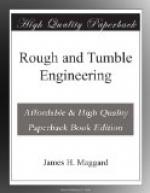LEAD
What is lead? Lead is space or opening of port on steam end of cylinder, when engine is on dead center. (Dead center is the two points of disc or crank wheel at which the crank pin is in direct line with piston and at which no amount of steam will start the engine.) Different makes of engines differ to such an extent that it is impossible to give any rule or any definite amount of lead for an engine. For instance, an engine with a port six inches long and one-half inch wide would require much less lead than one with a port four inches long and one inch wide. Suppose I should say one-sixteenth of an inch was the proper lead. In one engine you would have an opening one-sixteenth of an inch wide and six inches long and in the other you would have one-sixteenth of an inch wide and four inches long; so you can readily see that it is impossible to give the amount of lead for an engine without knowing the piston area, length of port, speed, etc. Lead allows live steam to enter the cylinder just ahead of the piston at the point of finishing the stroke, and forms a “cushion,” and enables the engine to pass the center without a jar. Too much lead is a source of weakness to an engine, as it allows the steam to enter the cylinder too soon and forms a back pressure and tends to prevent the engine from passing the center. It will, therefore, make your engine bump, and make it very difficult to hold the packing in stuffing box.
Insufficient lead will not allow enough steam to enter the cylinder ahead of piston to afford cushion enough to stop the inertia, and the result will be that your engine will pound on the wrist pin. You most likely have concluded by this time that “lead” is no small factor in the smooth running of an engine, and you, as a matter of course, will want to know how you are to obtain the proper lead. Well don’t worry yourself. Your engine is not going to have too much lead today and not enough tomorrow. If your engine was properly set up in the first place the lead will be all right, and continue to afford the proper lead as long as the valve has not been disturbed from its original position; and this brings us to the most important duty of an engineer as far as the engine is concerned, viz: Setting the Valve.
Setting A valve.
The proper and accurate setting of a valve on a steam engine is one of the most important duties that you will have to perform, as it requires a nicety of calculation and a mechanical accuracy. And when we remember also, that this is another one of the things for which no uniform rule can be adopted, owing to the many circumstances which go to make an engine so different under different conditions, we find it very difficult to give you the light on this part of your duty which we would wish to. We, however, hope to make it so clear to you that by the aid of the engine before you, you can readily understand the conditions and principles which control the valve in the particular engine which you may have under your management.




